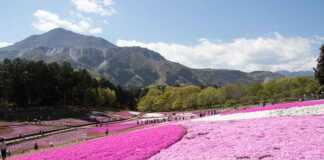Kyoto is home to famous temples and traditional culture. The city has picturesque wooden streets, well-preserved ancient temples and buildings, stunning shrines and gardens, towering pagodas, colourful cherry blossoms or sakura, mysterious geishas, tea ceremonies, traditional izakayas and the famous Arashiyama forest. While the city is beautiful during the day, Kyoto at night is magical.
If there is one Japanese city other than Tokyo that everyone knows of, it’s Kyoto. Once the centre of Japan’s Imperial dynasty, this charming historic city is now the cultural capital of Japan and a major tourist destination. Although the modern municipality of Kyoto was established in 1889, the city retains most of its centuries-old cultural heritage dating back more than a thousand years. While Tokyo represents the modern side of Japan, Kyoto maintains its traditional charm with more modern buildings and developments interspersed with centuries-old buildings and shrines.
Indulge in activities ranging from window shopping in a centuries-old market, geisha-spotting in Gion, admiring the intricacies of a tea ceremony, wearing a Kimono, dressing like a samurai or ninja, admiring a traditional Japanese art show and visiting a night cherry blossom festival. While the city has many modern spots to shop and relax, you can truly appreciate Kyoto by visiting the traditional areas and being close to Japanese culture.
Contents
- Kyoto At Night
- 20 Things To Do In Kyoto At Night
- 1- Visit the Famous Gion Geisha District On A Cultural Tour
- 2- Catch The Nightlife Of Pontocho Alley
- 3- Enjoy A Traditional Japanese Tea Ceremony
- 4- Taste Japan’s Traditional Sake
- 5- Enjoy Kyoto’s Culinary Culture By Going On A Night Food Tour
- 6- Try Japanese Street Food At The Iconic Nishiki Market
- 7- Take A Night Tour Of Kyoto’s Shrines And Lantern Lit Lanes
- 8- Hike To Fushimi Inari Temple And Catch The Sunset
- 9- Visit The Beautiful Yasaka Jinja Shrine And Attend Gion Matsuri
- 10- Attend A Samurai Class
- 11- Watch Nijo Castle’s Night Cherry Blossom Illumination Festival
- 12- Watch A Performance At Minami-za Kabuki Theatre
- 13- Shop In The Teramachi And Shinkyogoku Shotengai
- 14- Take In The Views From Kyoto Tower Observation Deck
- 15- Relax In A Zen Garden
- 16- Dress Up Like A Ninja
- 17- Stroll Along The Kamogawa River With A Beer
- 18- Watch The Sunset From The Kiyomizu-Dera Temple
- 19- Don’t Forget To Shop For Japanese Souvenirs
- 20- Enjoy A Meal In An Izakaya And Soak In An Onsen
Kyoto At Night
Top Tours
- Kyoto Night Walk in Gion Geisha District – most popular!
- Kyoto Evening Cherry Blossom and Food Tour – quintessential Japan.
- Kyoto 3-hour Guided Food Tour in Gion at Night – meet new friends and enjoy Japanese food
- Private Tour With Nationally Licensed Guide – Customise your own itinerary!
- Kyoto Kimono Rental – snap photos for your IG feed.
20 Things To Do In Kyoto At Night
1- Visit the Famous Gion Geisha District On A Cultural Tour
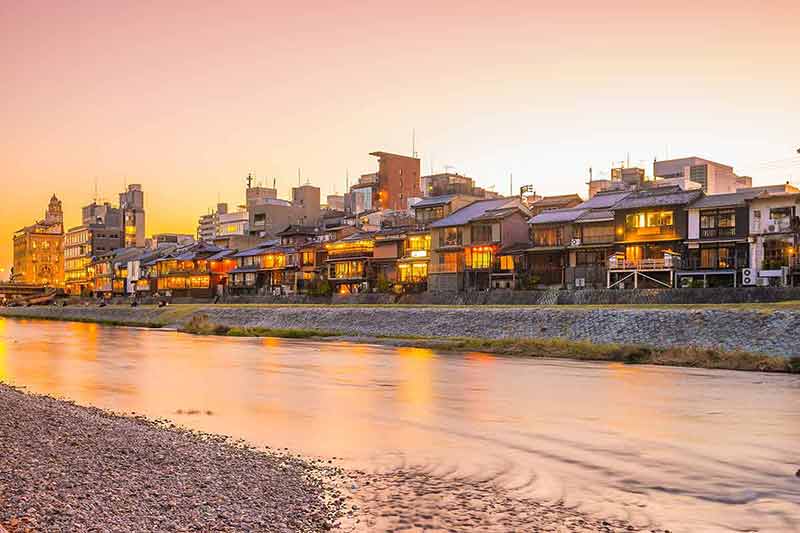
A tour of the Gion district is one of the most popular items on anyone’s bucket list while visiting Kyoto.
Gion has been the city’s central entertainment district for hundreds of years, being close to the famous Yasaka Shrine.
The district is the most exclusive and one of Japan’s remaining true Geisha districts.
Geishas today are well-respected ladies who make a living by entertaining visitors through song and dance.
Modern Geishas in Gion are true artists who can be distinctly made out by their visually striking artistic appearance.
Walking along the timeless streets of Gion (especially near Hanamikoji Street and Shirakawa Canal), you can catch a glimpse or two of Geishas.
You can watch their performance if you are lucky to enter a well-known Ochaya (teahouse). This tour is extremely popular, so book in advance to ensure you don’t miss out.
Hanamikoji Street Is at Gionmachi Minamigawa, Kyoto.
2- Catch The Nightlife Of Pontocho Alley
Pontocho Alley is a centuries-old narrow street in Kyoto famous for its fantastic restaurants, bars and dining options.
Unlike popular dining streets in other cities, bright lights and neon-sign boards are not allowed in this street which retains its unique old-world charm and exclusive ambience.
The street is famous for its various dining options, from casual food options like yakitori to traditional and modern Kyoto cuisine and many international cuisines.
Some establishments also require invitations or reservations, especially during summer months after sunset. Join this bar-hopping tour to get the lay of the land.
Pontocho Alley is at Pontocho Dori, Nakagyo-ku, Kyoto.
3- Enjoy A Traditional Japanese Tea Ceremony
Japan is famous for its tea ceremonies. While preparing tea and presenting it to family or guests isn’t a ceremony in the true sense of the word, it is a cultural activity that is quite important in Japan.
Drinking tea at a gathering often includes light snacks and sweets, or it can be a more formal event to include lunch or dinner.
The Japanese tea ceremony has its roots in Kyoto.
The perfect place to experience Japanese hospitality and culture is a Chashitsu or a tea room, sitting on a Tatami or a Japanese floor mat.
For an even more authentic experience, you can wear a kimono and drink tea like a local.
4- Taste Japan’s Traditional Sake
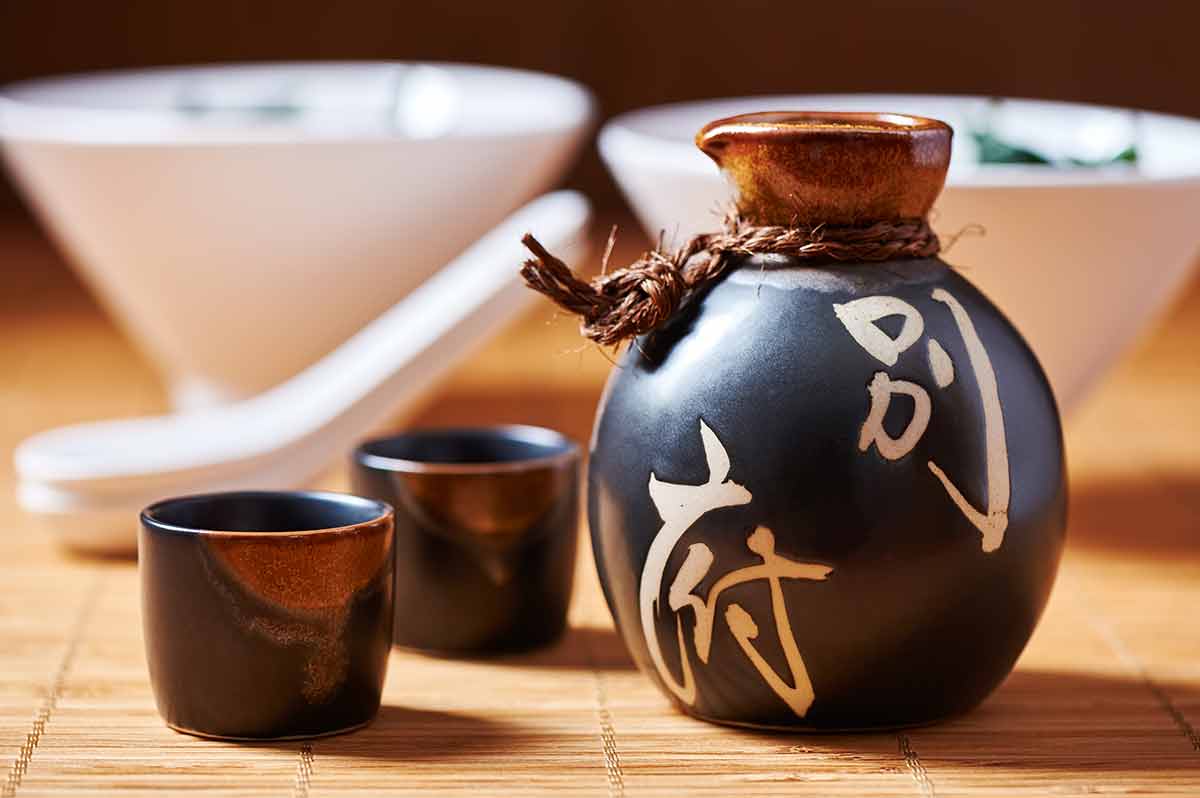
Sake, or Japanese rice wine, is an alcoholic beverage made by fermenting polished rice (without the bran).
Sake is made through a process similar to making beer (and not wine as the name suggests), but has an alcohol content much higher than beer (15% ABV in Sake compared to less than 9% ABV in normal beer).
A good way to experience Sake is to visit a factory such as the Gekkeikan Okura, a 400-year-old Sake brewing factory.
You can learn about the brewing process of Sake and also do a tasting of various types of Sake.
Make sure you don’t go to the tasting on an empty stomach.
5- Enjoy Kyoto’s Culinary Culture By Going On A Night Food Tour
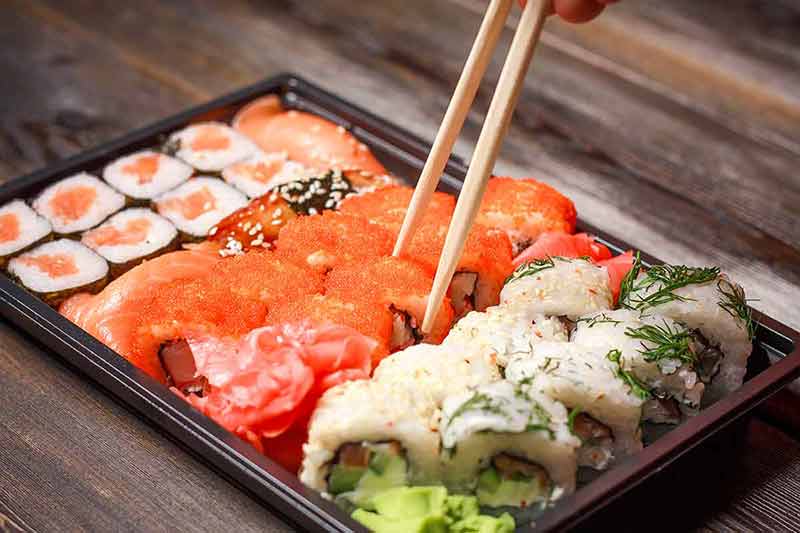
If you love to understand the food culture and seek out the hidden culinary gems in a city, you should hop on a food tour.
Kyoto has many hidden cafes and exclusive establishments.
Gion and Pontocho areas are popular for the many sought-after restaurants, tea houses and izakayas dishing up various food and bar options.
A Japanese guide is indispensable in such areas where you can gain exclusive entry into some of these establishments.
The neighbourhoods around Nishiki Market are also lined up with many street food options.
Many areas and streets close to the Kamo river also have many dining options.
For those of you who have specific dietary requirements or want to try out Japanese dining options suitable to your palate, a food tour guide would help you make the right choices.
For more about Japan, read:
- 20 Incredible Landmarks in Japan
- 20 Best Beaches In Japan
- 25 Things To Do In Tokyo At Night
- 25 Landmarks In Tokyo
- A Guide To Winter In Japan
- 50 Things To Do In Japan
- Japan Itinerary (10 days)
- Where To Stay In Tokyo
- Osaka Itinerary
- Nagoya Itinerary
- Where To Stay In Nagoya
- 12 Things To Do in Takayama
- How To Use The Toilets In Japan
- Osaka Itinerary
- 20 Things To Do In Osaka At Night
- Where To Stay In Osaka
- 20 Things To Do In Hiroshima
- Where To Stay In Hiroshima
- 20 Things To Do In Yokohama
- 15 Things Japan Is Famous For
- 20 Things To Do In Kamakura
- 20 Things To Do In Nagano
- 20 Day Trips From Tokyo
- 3 Day Trips From Osaka
- The Most Beautiful Japan Tourist Spots
- Hakuba Hotels
- Hakuba Ski Resort
- Japanese Onsen Tips
- Where To Stay In Kyoto Like A Local
- Arashiyama Monkey Park
- Eating and Drinking Matcha
- Amanemu Review
- 20 Japanese Drinks
- 20 Things To Do In Kyoto At Night
- 20 Japanese Cities
- 20 Things To Do In Fukuoka
- Where To Stay In Fukuoka
- 20 Things To Do In Nara
- 20 Things To Do In Hakone
- 20 Things To Do In Sapporo
- Where To Stay In Sapporo
- 20 Things To Do In Kanazawa
- 20 Things To Do In Okinawa
- 20 Things To Do In Sendai
- 20 Things To Do In Saitama
6- Try Japanese Street Food At The Iconic Nishiki Market
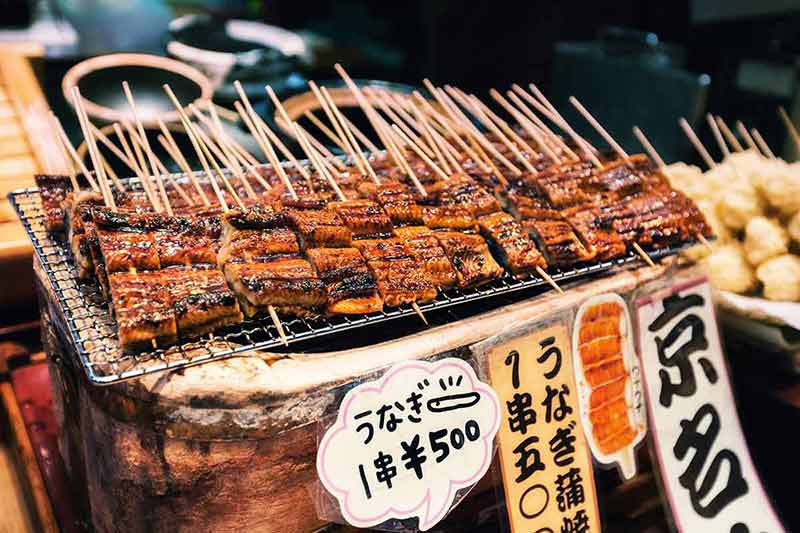
Nishiki Market is a 700-year-old market and food street in Kyoto with a wide range of street food options and shops.
Aptly named ‘The kitchen of Kyoto’, you can try fried octopus balls, sweet and savoury stuffed bread, Japanese omelettes, fried fish cakes, Yatsuhashi and lots more.
The market is also popular among locals for its range of high-quality ingredients.
The market is usually crowded and in the evenings after sunset before closing is the best time to visit.
Nishiki Market is at 609 Nishidaimonjicho, Nakagyo Ward, Kyoto. Check out the details of this market tour and cooking class.
7- Take A Night Tour Of Kyoto’s Shrines And Lantern Lit Lanes
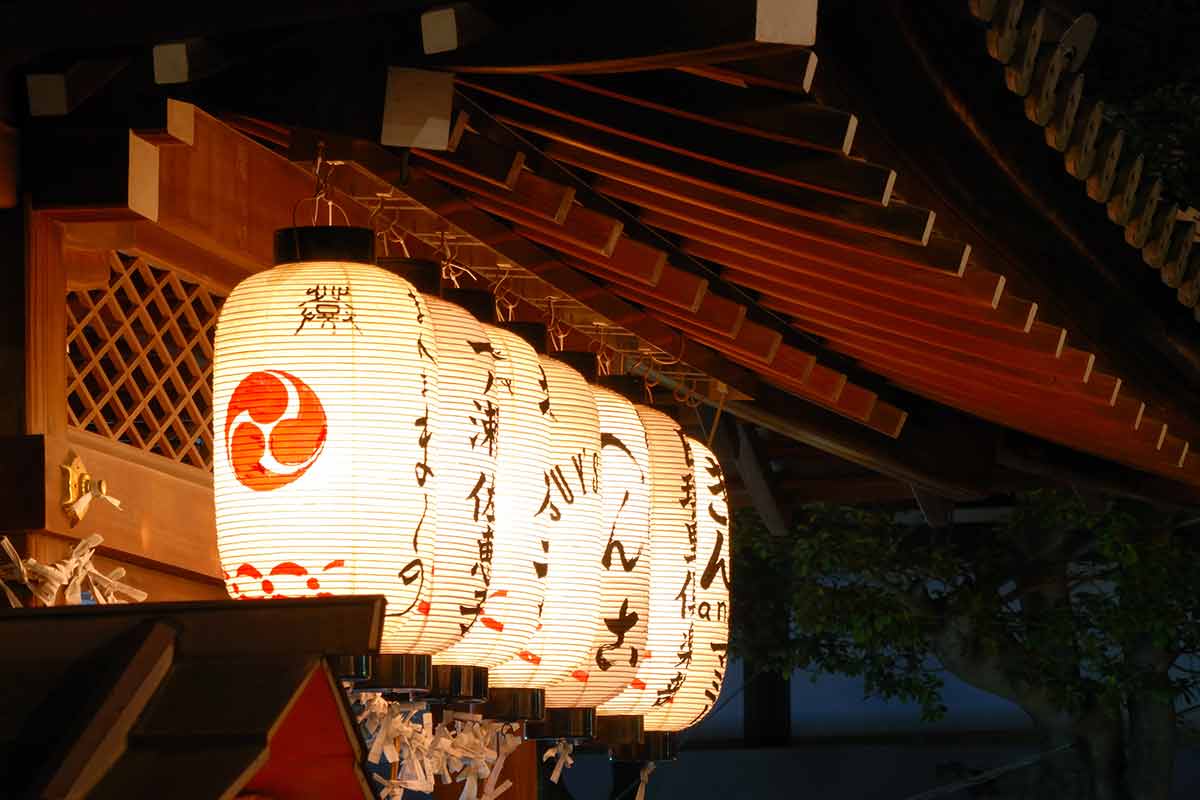
Kyoto is a city that combines tradition with modernity, and the best time to see this confluence of the old and new is after sunset.
Many shrines, buildings and streets come alive at night, showcasing beautiful colours and architectural styles.
Shrines such as Yasaka, Kiyomizu-Dera, Fushimi Inari, Kinkaku-ji, Kyoto Imperial Palace and To-ji are beautifully illuminated after sunset every day.
Many popular streets in Kyoto, such as the Sannenzaka, Pontocho, Shijo-Dori, and Shimbashi-Dori, are centuries old.
Many still use lanterns hung on wooden lamp posts and walking through these streets will make you feel like you are walking in a movie set.
Depending on the season, you can also view special festival lighting in many shrines, while the whole city becomes colourful and festive during the Gion Matsuri in July. Find out more about it by joining this tour.
8- Hike To Fushimi Inari Temple And Catch The Sunset
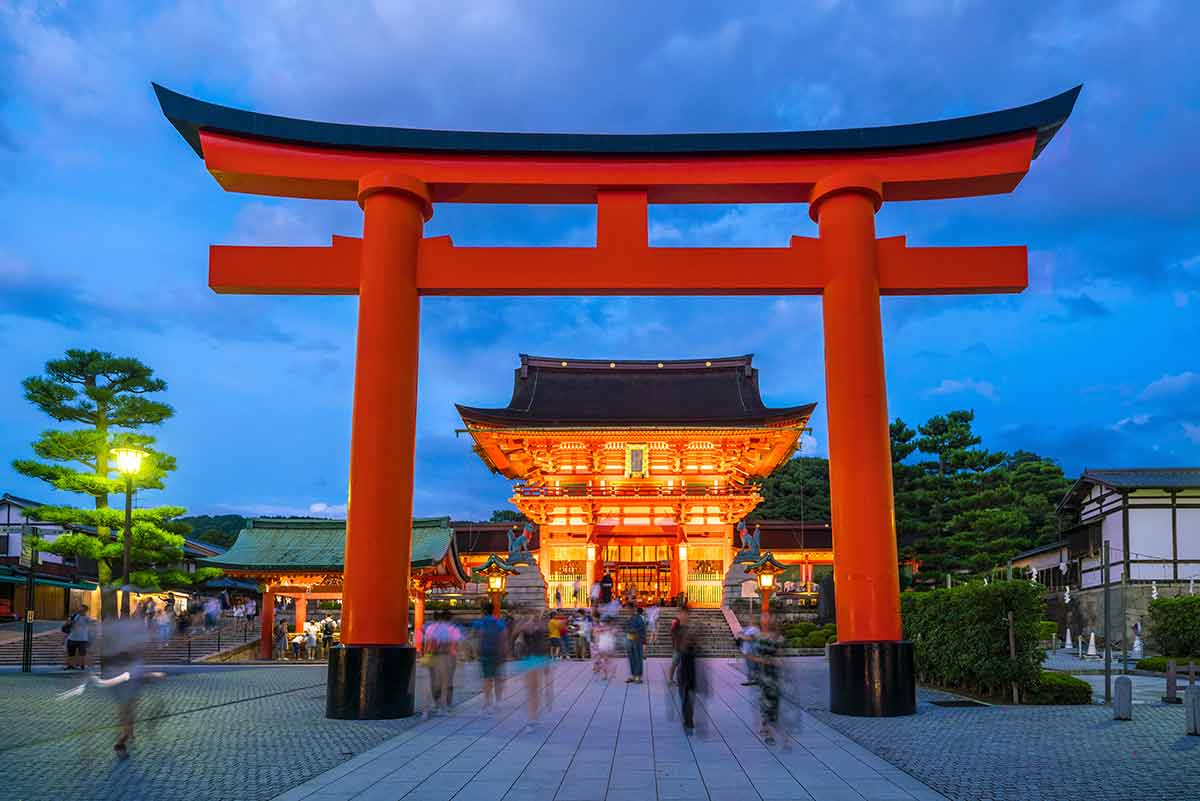
Fushimi Inari Taisha temple is one of Kyoto’s most iconic and must-visit sights and an important Shinto shrine in Japan.
The temple is dedicated to Inari, the Shinto god of rice and is also known as the ‘fox shrine’ as foxes are regarded as messengers of Inari.
The highlight of the shrine is the hundreds of bright-coloured gates called Senbon Torii, which cover the walking trail along the mountain and make for terrific Instagram shots.
The time slightly before and after sunset is perfect for taking pictures, while it takes a couple of hours to walk and cover the temple grounds.
Fushimi Inari is at 68 Fukakusa Yabunouchicho, Fushimi Ward, Kyoto and is open 24 hours. Book this private tour with a licensed guide will allow you to customise your night in Kyoto.
9- Visit The Beautiful Yasaka Jinja Shrine And Attend Gion Matsuri
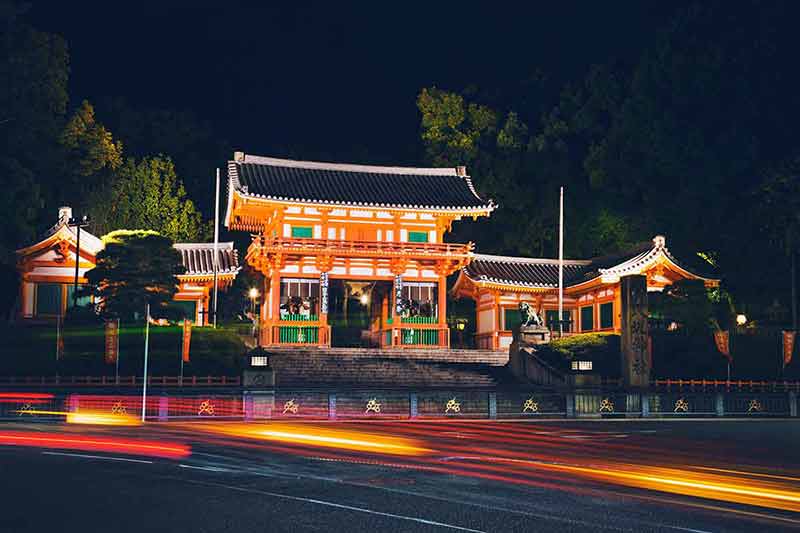
There are many beautifully lit Shrines at night, and one of the most beautiful and famous ones is the Yasak Jinja Shrine in the Gion district.
Built over 1000 years back, Yasaka Shrine sits at the edge of Maruyama Park, the oldest park in Kyoto.
The Shrine is close to the central areas and the Gion and is open 24 hours, meaning you can include it along with any other plans in that area.
The Shrine is also one of the places where the famous Gion Matsuri festival is held every July in Kyoto.
The festival is celebrated for a whole month when different events are held each day of the month.
If you visit Kyoto in July, don’t miss the spectacular Procession of Floats on July 17th, when exquisitely decorated enormous floats are pulled through the city streets.
Yasaka Jinja Shrine is at 625 Gionmachi Kitagawa, Higashiyama Ward, Kyoto and open 24 hours.
10- Attend A Samurai Class
Samurais were highly disciplined Japanese warriors who belonged to the elite class of the Japanese military and were extremely well-trained in the art of battle.
Samurais took years of practice to achieve higher and more challenging levels of training and used strikingly deadly weapons to instil fear into their enemies.
Unlike the Ninjas, who focused on stealth and secrecy, Samurais followed a code to follow in battle and primarily operated in open combat.
Attend a Samurai class where you can learn the basics and history of these warriors, dress up in a warrior kimono, wield a sword and learn some deadly moves, get a souvenir photo in the Samurai suit, get a certificate of achievement and also get bragging rights.
Samurai & Ninja Museum With Experience is at 292 Utanokoji-bldg, Higashidaimonjicho, Nakagyo Ward, Kyoto.
11- Watch Nijo Castle’s Night Cherry Blossom Illumination Festival
Nijo is a centuries-old castle with large gardens and hundreds of Japanese cherry trees, or Sakura.
From March to April, the trees in the castle gardens come alive with flowers, and people flock to see the night blossoms.
During this season, you can enter the castle grounds after sunset by taking a night ticket and viewing the colourful and brightly lit trees.
The festival also showcases colourful 3-D projection mappings, interactive displays and other beautiful decorations.
You can also visit other locations in Kyoto, like the Arashiyama, Ninnaji Temple, Kyoto Botanical Gardens, Kyoto Gyoen National Garden, Philosopher’s Path, and Maruyama Park to enjoy the cherry blossoms.
Many of these attractions have an entry ticket, and advance booking can be cheaper in some places.
Nijo Castle is at 541 Nijojocho, Nakagyo Ward, Kyoto and the night festival runs from 6 pm to 9 pm during the cherry blossom period.
12- Watch A Performance At Minami-za Kabuki Theatre
The Minamiza is one of Japan’s most famous kabuki theatres known for traditional performances symbolising Japanese culture.
Kabuki is a Japanese art form that involves elaborately designed costumes, eye-catching make-up and wigs, and exaggerated expressions and actions performed by the actors.
The theatre uses dynamic stage props such as revolving trapdoors and a footbridge that leads through the audience, allowing for a dramatic entry or exit by the actors.
While catching a performance at this theatre should be on your bucket list, checking out the beautifully lit building at night is also worth the sight.
Minamiza Theatre is at 198, Nakanocho, Higashiyama Ward, Kyoto and show.
13- Shop In The Teramachi And Shinkyogoku Shotengai
A great place to shop in Kyoto is the Shotengai, which are traditional shopping areas that are permanently covered and accessible all through the year.
Two popular Shotengai run parallel to each other: Teramachi Shotengai and Shinkyogoku Shotengai.
Teramachi’s shops offer more traditional Japanese ware and items relevant to families and older crowds.
Shinkyogoku is where you can shop for anything from clothing to iPhone covers, and it usually attracts a younger crowd.
You can do your souvenir shopping here and enjoy traditional tea or ice cream afterwards.
A couple of kilometres from here is the Sanjo-kai Shotengai, another shopping area frequented by locals for their shopping needs.
Teramachi Shotengai is at Shimohonnojimaecho, Nakagyo Ward, Kyoto
Shinkyogoku Shotengai is at 548-3 Nakanocho, Nakagyo Ward, Kyoto
14- Take In The Views From Kyoto Tower Observation Deck
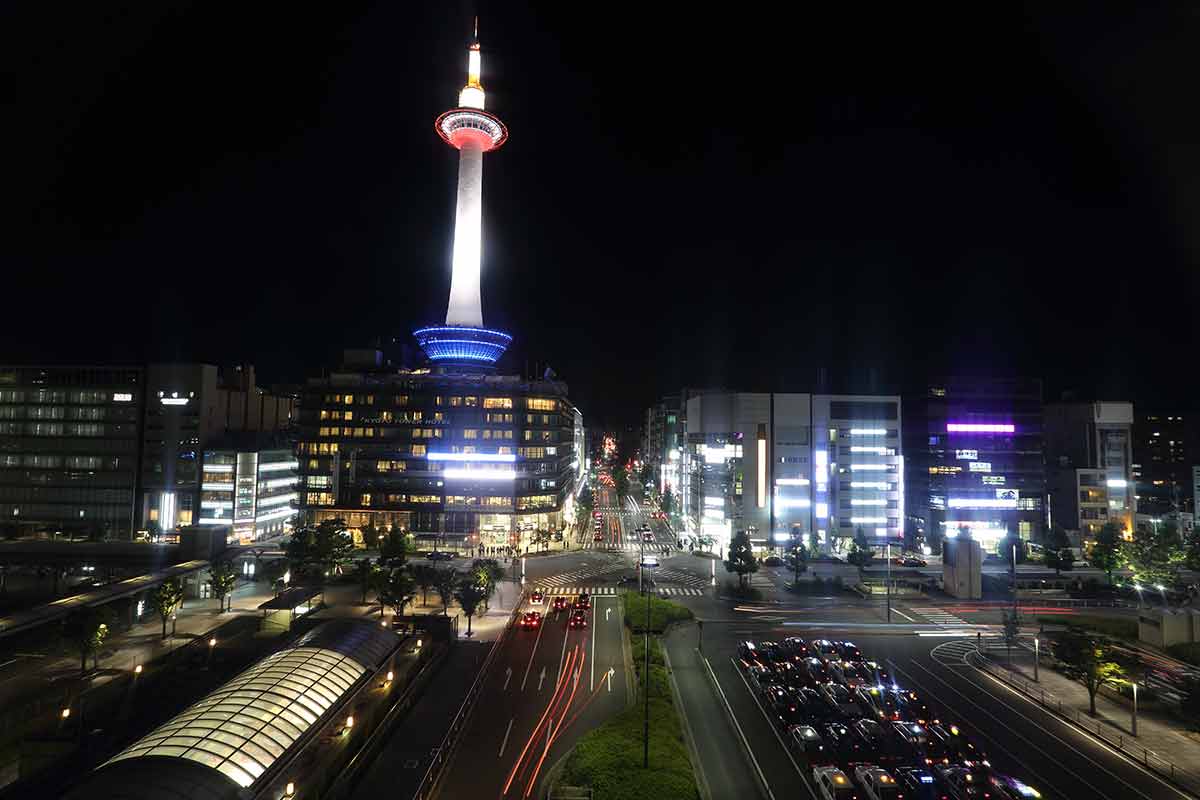
Kyoto Station is a central transportation hub in Western Japan and is housed in one of Japan’s biggest buildings.
The station has hundreds of trains running through it daily, including the Shinkansen (bullet train).
Train aficionados will love riding a bullet train or taking a snap of it while in Kyoto.
The station building also has a skywalk on the top of the building, which gives beautiful sunset views along with Kyoto’s skyline.
The station also has many LED-lit steps, which give a brilliant display regularly featuring Japanese festivals and traditions.
Close to the Kyoto Station is the Kyoto Tower, the tallest building in the city.
The tower has an observation deck that gives a panoramic view of the whole city, and the tower itself is a beacon in the night in Kyoto that can be seen from everywhere in the city.
Kyoto Station is at Higashishiokojicho, Shimogyo Ward, Kyoto and is always open. Kyoto Tower is at 721-1 Higashishiokojicho, Shimogyo Ward, Kyoto and is open till 9 pm.
15- Relax In A Zen Garden
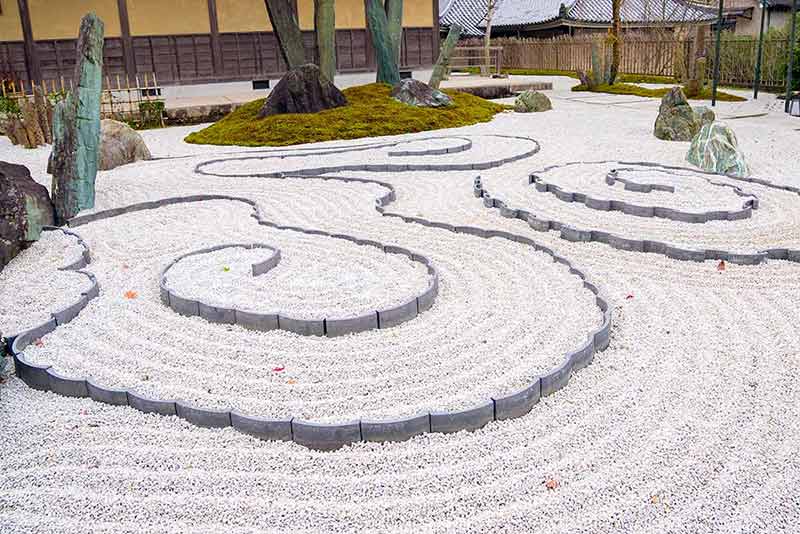
A great way to wind down like a local after sightseeing in Kyoto is to head over to a Zen Garden.
The city is Japan’s Zen Buddhism spiritual centre and has some of the best Zen Gardens in Japan.
Unlike a traditional garden with trees and water bodies, a Zen Garden is more austere and has gravel and rocks to give the appearance of buildings, water or even features like waves.
Trees often surround the area around the Zen Garden, but most Zen Gardens are generally comprised of gravel and rocks, scattered in unique, interesting ways symbolising the combination of nature and spirituality.
Many temples have accompanying Zen Gardens, a place to eat, and beautiful views at sunset.
16- Dress Up Like A Ninja
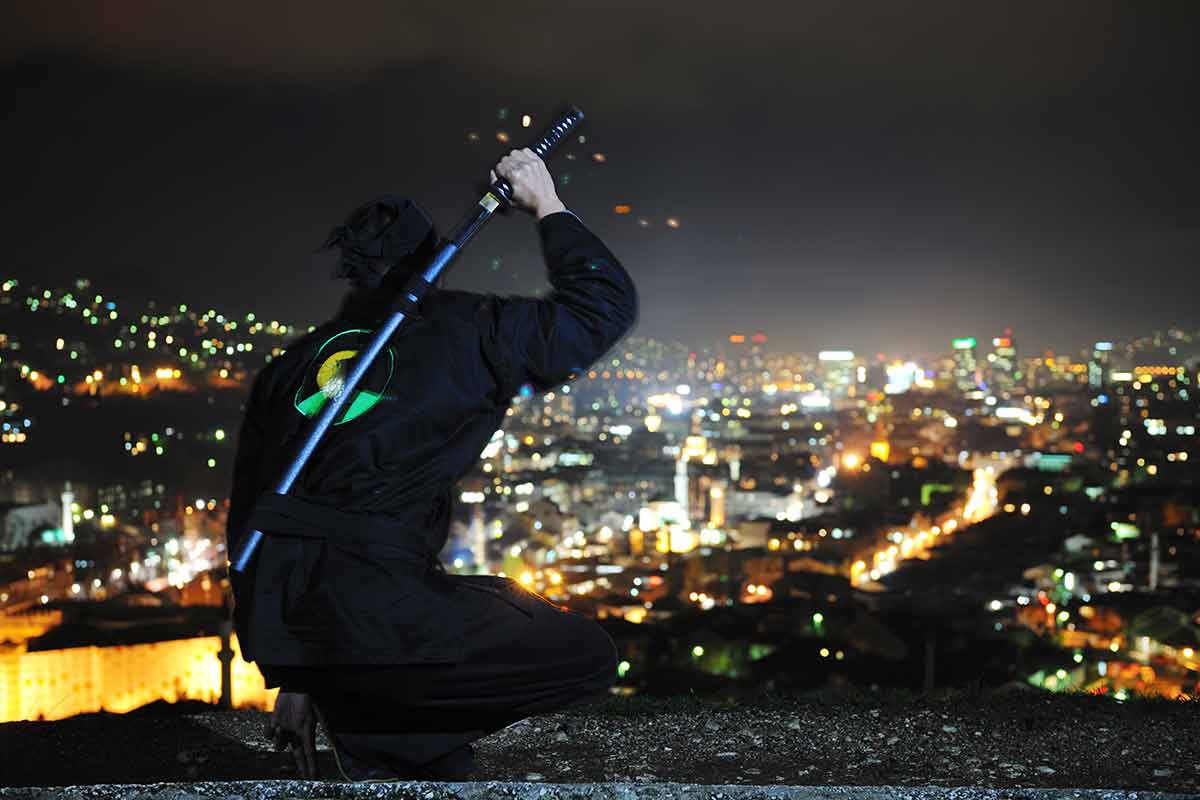
One of the most famous characters in Japanese folklore is the Ninja.
Who hasn’t played or dressed up as a Ninja at some point during their childhood, watched a show or movie with Ninjas, and had fun trying to act stealthily and menacingly like a Ninja?
When visiting Kyoto, you can have a cool and fun Ninja experience where you can learn more about the importance of these characters and why they are so popular.
You can also visit a Ninja museum and get a chance to dress up and act like one.
Ninja Museum is at 604-8043, Nakagyo Ward, Higashidaimonjicho, 292Utanokoji-bldg, Kyoto.
17- Stroll Along The Kamogawa River With A Beer
The Kamogawa (Kamo) is a 31-km long river that goes through Kyoto and is accessible from many popular tourist spots.
The river banks are a popular local hangout spot and an excellent place to feel the evening breeze or listen to street musicians playing music.
You can meet people, hang out with friends or just have a relaxing time on the banks of the river.
Don’t forget to pick up some snacks and a beer from a nearby convenience store before heading over to the river banks!
Kamo River can be reached by walking down from the Shijo bridge.
18- Watch The Sunset From The Kiyomizu-Dera Temple
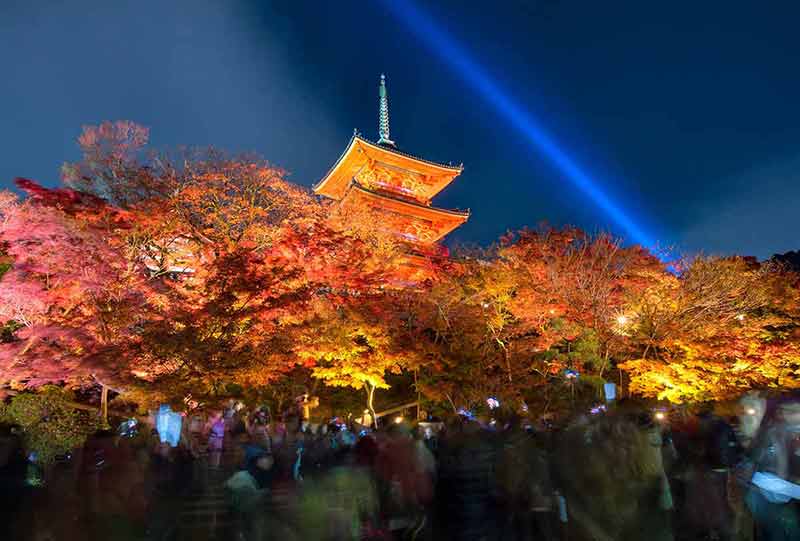
Kyoto has many ancient temples that are worth visiting.
From scenic views to wide open vistas to peaceful zen gardens to picturesque cherry blossoms, every temple has some uniqueness that can enthral you.
Kiyomizu-Dera is a 1200-year-old temple on a mountain near Kyoto.
It is extremely popular for its scenic views, wide open spaces, gardens, water streams, three-storeyed pagoda, tea houses and seasonal light festivals.
One of the best sunset views in Kyoto is from the west side gate, where you can see the sun setting slowly across the panoramic view of Kyoto.
You can even try Nissokan, a simple Buddhist meditation method during sunset which can be very relaxing.
If you visit the temple during the autumn or spring, you will be treated to a brilliant display of colourful trees and mountain slopes.
Three times every year, the temple is open for night viewing when many parts of the temple grounds are lit, adding to the mystical feel of the temple.
Kiyomizu-Dera temple is at 1 Chome-294 Kiyomizu, Higashiyama Ward, Kyoto and is open till 6 pm on normal days. The temple is open till 9.30 pm during special night viewing days on March 25-April 2, Aug 14-16, Nov 18-30.
19- Don’t Forget To Shop For Japanese Souvenirs
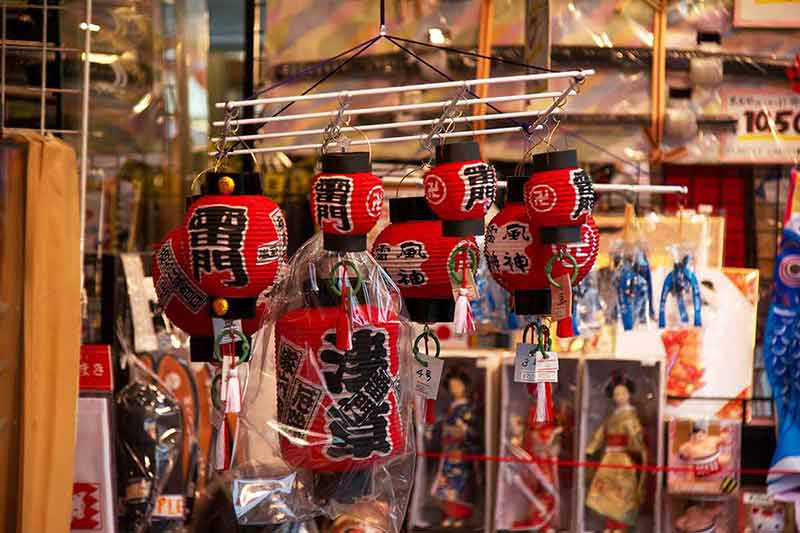
Kyoto is a city steeped in Japanese culture with the best selection of traditional Japanese arts, crafts and goods.
You can choose a souvenir of your trip in Kyoto from a selection of inexpensive and quintessentially Japanese souvenirs.
Some ideas are a yukata (summer robe) or a kimono, washi (traditional Japanese paper), lacquerware, printed woodblocks, jade figurines, stick chocolates, Japanese candy and confectionary or green tea.
You can also buy specific souvenirs that remind you of the beautiful places in Kyoto, like the Fox Rice Cracker in Fushimi Inari or a bowl with Kiyomizu-Dera printed on it.
Some places to go souvenir shopping are Nishiki Market, Shijo-Dori, Kyoto Handicraft Center, Higashiyama, and even the seasonal Flea Market on Toji Temple grounds.
- Nishiki Market is at 609 Nishidaimonjicho, Nakagyo Ward, Kyoto.
- Kyoto Handicraft Centre is at 17 Shogoin Entomicho, Sakyo Ward, Kyoto.
- Toji Temple is at 1 Kujocho, Minami Ward, Kyoto.
20- Enjoy A Meal In An Izakaya And Soak In An Onsen
An Izakaya is a cafe serving traditional Japanese food and drinks in a casual dining atmosphere.
Dining at a traditional Izakaya is a quintessential Japanese experience where a group of family or friends sit together and share food (and alcoholic drinks).
In Japanese culture, ordering small quantities of different types of food shared by everyone around the table, along with accompanying drinks, is a very common experience.
Make sure to drink sake when in an Izakaya.
Your trip to Kyoto wouldn’t be complete without taking a dip in a traditional Onsen or a hot spring.
Geo-thermally heated water springs are popular in Japan for their healing properties and warmth on a cold day.
Kyoto has a mix of natural and artificially maintained Onsens, and the experience of getting into a hot water spring with proper bath etiquette is an experience in itself.
For more exciting cities at night, read:
- 20 Things To Do In Boston At Night
- 21 Things To Do In Los Angeles At Night
- 20 Things To Do In San Francisco At Night
- 20 Things To Do In London At Night
- 15 Things To Do In Rome At Night
- 16 Things To Do In Melbourne At Night
- 20 Things To Do In New York At Night
- 20 Things To Do In Miami At Night
- 22 Things To Do In Pittsburgh At Night
- 20 Things To Do In New Orleans At Night
- 20 Things To Do In Atlanta At Night
- 26 Things To Do In Toronto At Night
- 20 Things To Do In Vancouver At Night
- 20 Things To Do In Mexico City At Night
- 20 Things To Do In Detroit At Night
- 20 Things To Do In Nashville At Night
- 20 Things To Do In Portland At Night
- 20 Things To Do In Barcelona At Night
- 20 Things To Do In Lisbon At Night
- 20 Things To Do In Athens At Night
- 20 Things To Do In Manhattan At Night
- 20 Things To Do In Cairo At Night
- 20 Things To Do In Krakow At Night
- 20 Things To Do In Seoul At Night
- 20 Things To Do In Shanghai At Night
- 20 Things To Do In Chengdu At Night
- 20 Things To Do In Chongqing At Night
- 20 Things To Do In Kuala Lumpur At Night
- 20 Things To Do In Beijing At Night
- 20 Things To Do In Kyoto At Night
- 20 Things To Do In Munich At Night
- 17 Things To Do In Ibiza At Night
- 20 Things To Do In Mumbai At Night
- 19 Things To Do In Montreal At Night
- 20 Things To Do In Dubai At Night
- 20 Things To Do In Delhi At Night
- 20 Things To Do In San Antonio At Night
- 20 Things To Do In Chiangmai At Night
- 20 Things To Do In Sydney At Night
- 20 Things To Do In Paris At Night
- 25 Things To Do In Tokyo At Night
- 20 Things To Do In Houston At Night
- 24 Things To Do In Dallas At Night
- 20 Things To Do In Chicago At Night
- Macau Nightlife
- 23 Things To Do In Hong Kong At Night
- 20 Things To Do In Las Vegas At Night
- 20 Things To Do In San Diego At Night
- 20 Things To Do In Seattle At Night
- 20 Things To Do In Philadelphia At Night
- 20 Things To Do In Orlando At Night
- 20 Things To Do In Berlin At Night
- 20 Things To Do In Prague At Night
- 20 Things To Do In Denver At Night
- 20 Things To Do In Istanbul At Night
- 20 Things To Do In Venice At Night
- 20 Things To Do In Budapest At Night
- 20 Things To Do In Madrid At Night
- 20 Things To Do In Rio At Night
- 20 Things To Do In Bangkok At Night
- 20 Things To Do In Reykjavik At Night
- 20 Things To Do In Dublin At Night
- 20 Things To Do In Brussels At Night
- 20 Things To Do In Milan At Night
- 20 Things To Do In St Augustine At Night
- 20 Things In Tampa At Night
- 20 Things To Do In Osaka At Night
- 20 Things To Do In Niagara Falls At Night
- 20 Things To Do At Night In Florence
- 20 Things To Do In St Louis At Night
- 20 Things To Do in Cleveland At Night
- 20 Things To Do In Doha At Night
- 20 Things To Do In Copenhagen At Night
- 20 Things To Do In Ottawa At Night
- 20 Things To Do In Bali At Night
Plan Your Trip

Rent A Car – Find the best car rental rates at Discover Cars. They compare car hire companies to provide you with the best deal right now.

Find A Hotel – If you’re curious about this article and are looking for somewhere to stay, take a look at these amazing hotels.
